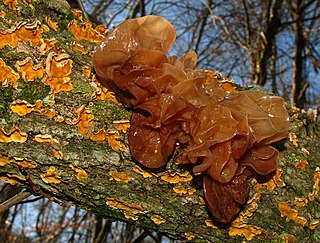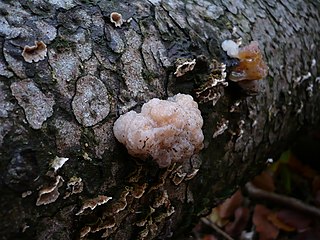
Tremella is a genus of fungi in the family Tremellaceae. All Tremella species are parasites of other fungi and most produce anamorphic yeast states. Basidiocarps, when produced, are gelatinous and are colloquially classed among the "jelly fungi". Over 100 species of Tremella are currently recognized worldwide. One species, Tremella fuciformis, is commercially cultivated for food.

Myxarium nucleatum is a species of fungus in the family Hyaloriaceae. In the UK, it has been given the recommended English name of crystal brain. The fruit bodies are watery white, pustular or lobed, and gelatinous with small, white, mineral inclusions visible to the naked eye. It is a common, wood-rotting species in Europe, typically growing on dead attached or fallen branches of broadleaf trees. It is currently not clear whether collections from North America and elsewhere represent the same species.

Phaeotremella is a genus of fungi in the family Phaeotremellaceae. All Phaeotremella species are parasites of other fungi and produce anamorphic yeast states. Basidiocarps, when produced, are gelatinous and are colloquially classed among the "jelly fungi". Fifteen or so species of Phaeotremella are currently recognized worldwide. Tremella sanguinea, shown to be a Phaeotremella species by DNA sequencing, is cultivated in China as an ingredient in traditional Chinese medicine.

Phaeotremella frondosa is a species of fungus in the family Phaeotremellaceae producing brownish, frondose, gelatinous basidiocarps. It is widespread in north temperate regions, and is parasitic on other species of fungi that grow on dead attached and recently fallen branches of broadleaf trees.

Phaeotremella foliacea is a species of fungus in the family Phaeotremellaceae. It produces brownish, frondose, gelatinous basidiocarps and is parasitic on the mycelium of Stereum sanguinolentum, a fungus that grows on dead attached and recently fallen branches of conifers. It is widespread in north temperate regions. In the UK it has the recommended English name leafy brain and has also been called jelly leaf and brown witch's butter. Prior to 2017, the name Tremella foliacea was also applied to similar-looking species on broadleaf trees, now distinguished as Phaeotremella frondosa and Phaeotremella fimbriata.

Naematelia is a genus of fungi in the family Naemateliaceae. All Naematelia species are parasites of other fungi and produce anamorphic yeast states. When produced, Basidiocarps ,, are gelatinous and are colloquially classed among the "jelly fungi."Four species of Naematelia are currently recognized worldwide. One species, Naematelia aurantialba, is commercially cultivated for food.

Naematelia aurantia is a species of fungus producing yellow, frondose, gelatinous basidiocarps. It is widespread in north temperate regions and is parasitic on another species of fungus that grows on dead attached and recently fallen branches of broadleaf trees. It is commonly called golden ear in North America.
Phaeotremella roseotincta is a species of fungus in the family Phaeotremellaceae. It produces pinkish to pale pinkish brown, frondose, gelatinous basidiocarps and grows on dead attached and recently fallen branches of broad-leaved trees. It was originally described from Japan and has also been recorded from far eastern Russia.

Phaeotremella mycophaga is a species of fungus in the family Phaeotremellaceae. It produces small, pustular, gelatinous basidiocarps on the hymenium of the corticioid fungi Aleurodiscus amorphus and A. grantii on conifers.

Tremella vesiculosa is a species of fungus in the family Tremellaceae. It produces light brown, lobed, gelatinous basidiocarps and is parasitic on other fungi on dead branches of broad-leaved trees. It was originally described from New Zealand.
Tremella samoensis is a species of fungus in the family Tremellaceae. It produces red to orange-yellow, lobed to firmly foliaceous, gelatinous basidiocarps and is parasitic on other fungi on dead branches of broad-leaved trees. It was originally described from Samoa and the Philippines, but is widely distributed in the region.
Tremella brasiliensis is a species of fungus in the family Tremellaceae. It produces yellow, lobed to firmly foliaceous, gelatinous basidiocarps and is parasitic on other fungi on dead branches of broad-leaved trees. It was originally described from Brazil.

Tremella globispora is a species of fungus in the family Tremellaceae. It produces hyaline, pustular, gelatinous basidiocarps and is parasitic on pyrenomycetous fungi on dead herbaceous stems and wood. It was originally described from England.
Tremella roseolutescens is a species of fungus in the family Tremellaceae. It produces rose-pink to salmon, pustular, gelatinous basidiocarps and is parasitic on other fungi on dead attached branches of broad-leaved trees. It was originally described from Costa Rica.
Tremella salmonea is a species of fungus in the family Tremellaceae. It produces pale orange to salmon, foliose, gelatinous basidiocarps and is parasitic on other fungi on wood of broad-leaved trees. It was originally described from China.
Tremella yokohamensis is a species of fungus in the family Tremellaceae. It produces white, foliaceous, gelatinous basidiocarps and is parasitic on other fungi on dead wood of broad-leaved trees. It was originally described from Japan.
Tremella versicolor is a species of fungus in the family Tremellaceae. It produces small, pustular, gelatinous basidiocarps and is parasitic on the basidiocarps of Peniophora species, a genus of corticioid fungi, on dead attached or recently fallen branches. It was originally described from England.
Tremella mesenterella is a species of fungus in the family Tremellaceae. It produces yellowish to reddish brown, foliose, gelatinous basidiocarps and is parasitic on corticioid fungi on dead branches of broadleaf trees and shrubs. It was originally described from Canada.
Phaeotremella translucens is a species of fungus in the family Phaeotremellaceae. It produces small, pustular, gelatinous basidiocarps and is parasitic on ascocarps of Lophodermium species on decaying pine needles. It was originally described from Scotland.
Pseudotremella moriformis is a species of fungus in the family Bulleraceae. It produces dark purple, pustular, gelatinous basidiocarps and is parasitic on pyrenomycetous fungi on dead herbaceous stems and wood. It was originally described from England.









